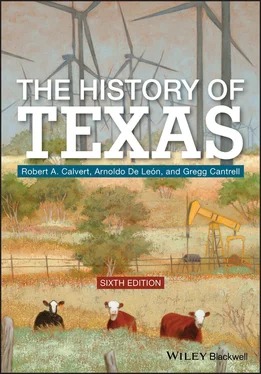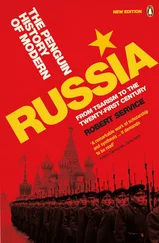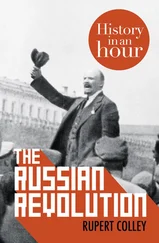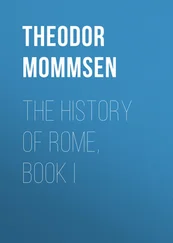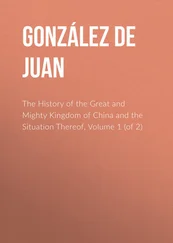It follows, therefore, that ethnocentrism or racism as a cause of the conflict has also received attention from scholars, with some arguing strongly that racial prejudice acted as a guiding force (though not the sole one) in the break with Mexico; others adamantly contest this analysis. The first school would note that Anglo Americans arrived in Texas already conditioned to think negatively of Mexican people: the Mexicans’ darker skin and adherence to Catholicism helped Protestant, racially biased Anglos view Mexicans as biologically inferior and morally flawed. Believing, as past generations of Anglos did (and future ones would) that the United States had a special purpose in the world (a “Manifest Destiny” to bring order and discipline to “untamed” and “uncivilized” hinterlands), they arrived in Texas bent on “rescuing” the underdeveloped region from a backward people and an unstable government.
Critics of such an interpretation argue that racism truly was not manifest in Texas before 1836, and thus should be discounted as a primary cause in the independence movement. In fact, Anglos and Tejanos coexisted fairly well, sharing similar economic and political interests. Frontier settlements were so remote that large‐scale contact between the two peoples hardly aroused ill feelings. But once it started, the war itself, one group of scholars observes, spurred anti‐Mexican prejudice. During the conflict, Anglos came to see Mexicans as decadent, brutal, and subhuman, the reality of the events that transpired during it hardening such perceptions. Still other scholars note that not until after 1836, when new factors emerged, among them a desire to turn Mexicans into a controllable labor force and stepped‐up competition for land, did feelings that may be classified as racist develop. Prejudice evolved from a need to justify the violent domination of the Tejanos, in short, from anxiety, distrust, fear, conflict, and competition.
Scholars also find the United States economy a contributing factor leading to the breakup of Texas with Mexico. Anglo American immigrants had facilitated closer economic ties between Texas (and other parts of the Far North for that matter) and the United States, so that by the 1830s, even Tejanos (both oligarchs and some plain folks) and entrepreneurs in Coahuila were forging connections to US commerce. When events pushed Texas toward separation from Mexico, many Texans (both Anglos and Mexicans)–driven by the human instinct for survival–sided with rebellion, seeing greater opportunity in an independent Texas tied to the robust economy of the United States.
Finally, after decades of relative neglect, the Revolution has come under the examination of historians from Mexico. Writing from a nationalistic perspective, they have tended to view the conflict as an expression of US imperialism–a shameless American land grab perpetrated against a weaker neighbor. In this view, the Texas War for Independence was simply the first step in the United States’ acquisition of Mexico’s northern territories, a process that started in Texas and then culminated in the US‐Mexican War of 1846–48. The Texas rebels, in other words, were simply surrogates for the US government, fully intending to detach Texas from Mexico and add it to the United States.
Whatever the immediate causes of the Texas War for Independence, the conflict must be considered in the larger social, political, and economic context of Mexican and American history. Texas by the 1830s was an isolated, peripheral region of the weak, incompletely formed Mexican nation. The events of the 1820s and 1830s had drawn Texas increasingly into the dynamic, rapidly expanding capitalist economic system of the United States, and those ties proved stronger than all of Mexico’s inadequate attempts to foster a Mexican identity and bind the northern frontier province more tightly to the national core. Shortly before the outbreak of the Revolution, Stephen F. Austin had described Texas as “a ripe peach” simply waiting for a “gentle breeze” to cause it to drop from its Mexican tree. The events of 1833–35, culminating in Santa Anna’s turn to Centralism, whipped up more than a breeze–it was more like a storm that had been brewing quietly for many years but finally broke.
Santa Anna arrived in Béxar on February 23, 1836, to find the Alamo (the popular name of the old mission of San Antonio de Valero) fortified by a contingent led by William Barret Travis and James Bowie. Laying siege to it, Santa Anna prepared for a final assault, as those inside mobilized for defense.
On March 6, sometime around the break of dawn, some 1100 of Santa Anna’s 2600 troops began a trot toward the walled compound as the degüello , a bugle call signaling to take no prisoners, sounded. The old mission would not fall easily; its location on a slight rise afforded those inside it a clear view of their attackers. Moreover, the defenders (historians now place their number in the range of 240 to 260) had already armed the compound with twenty‐one heavy artillery pieces, and many of those inside were expert riflemen, including foremost the Tennessee marksmen led by the recently arrived volunteer Davy Crockett, a nationally famous former US congressman. Using cannon fire and long rifles, the Alamo’s defenders felled the lead soldiers responsible for positioning the ladders that would allow the attackers to scale the mission’s defenses; thus officers and more‐seasoned fighters rushing behind the first wave could only try to claw their way up and over the compound’s eight‐ to nine‐foot walls. Now fighting for their lives, the Mexicans contended with bayonets and Bowie knives. Within minutes of its start, the assault appeared to have miscarried, and Santa Anna committed 400 reserves to the engagement. As this new wave of soldiers dashed toward the fortress, their bullets hit many of the hapless conscripts who still lay bunched up at the base of the walls. Frantic effort finally took the attackers over the walls of the Alamo, where the volunteers fell back to find cover within the compound ( Figure 3.6). The battle itself ended within thirty minutes, but the carnage followed for some time after, as the Mexicans ferreted out soldiers still resisting from makeshift secondary lines of defense. The assault had cost Santa Anna more than 200 deaths and total casualties of about 400.
Even though Santa Anna gave orders to spare no one’s life, several who had stood in the Alamo survived. Among them were Susannah Dickinson, her small child, and a black slave belonging to Travis. Many of the survivors were Mexicans, most of them family members of (what recent research reveals were) nine Tejanos who had chosen to stand and fight with those inside the Alamo. About six or seven volunteers–Davy Crockett probably among them–were captured and executed within minutes after the battle by orders of Santa Anna.
While Santa Anna was waging his costly victory at Béxar, Texans under the command of Colonel James W. Fannin were preparing to defend the old presidio at Goliad from Mexican forces advancing up the coast from Matamoros under the command of General José de Urrea, who had already disposed of Anglo resistance his forces had met at San Patricio, Agua Dulce, and Refugio. Fannin decided on the morning of March 19 to abandon the garrison and make a run for Victoria, reasoning that the lack of adequate provisions at Goliad undermined a capable defense. As Fannin and his men retreated, Urrea intercepted them, deterring the Texans from taking refuge at Coleto Creek, the ravined terrain of which might have allowed Fannin to dig in to mount a spirited resistance. Therefore, at the “battle of the prairie,” some two miles from the timber of Coleto Creek, Urrea forced Fannin to surrender on the morning of March 20, and then marched the enemy force back to Goliad. A week later, despite Urrea’s personal pleas for clemency for the prisoners, Col. Nicolás de la Portilla (whom Urrea had left in command at Goliad) slaughtered the Anglos at Santa Anna’s insistence. Some 312 persons met their death, but close to 30 men who had not been fatally wounded by the executioners’ first volley managed to escape into the woods.
Читать дальше
